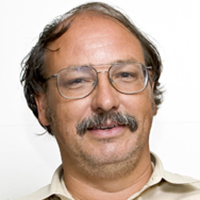
A pair of Florida State University astrophysicists have received new three-year grants totaling $738,000 from the National Science Foundation (NSF) to advance their research on space phenomena known as supernovae. Such research could yield new understanding of a mysterious force known as dark energy that is believed to account for the vast majority of the energy in the universe.
Christopher Gerardy, an assistant professor in the Department of Physics, is the primary investigator on a $371,000 grant titled “New Observational Constraints on Thermonuclear Supernovae.” Meanwhile, Associate Professor Peter Hoeflich is the lead researcher on a $367,000 grant from the NSF titled “Interaction of Thermonuclear Supernovae with Their Environment.”
“One of the most stunning discoveries of the past decade was the realization that the universe is expanding at an accelerating rate, which suggests the existence of a mysterious form of energy that we currently know very little about,” Hoeflich said. “Given the name ‘dark energy,’ this force comprises approximately 70 percent of the energy budget of the universe.
“Thermonuclear stellar explosions — so-called Type Ia supernovae — have been the main tool for this discovery,” he said. “A better understanding of these objects is necessary to decipher the nature of the dark energy, with implications for all physics.”

Type Ia supernovae play a crucial role in helping researchers develop a better understanding of fundamental physics, the origin of elements, and cosmology (the study of the universe), Gerardy added.
“These exploded stars are astrophysical laboratories that essentially allow us to study nuclear and atomic physics, as well as hydrodynamical and radiation transport effects, under extreme conditions,” he said. “Type Ia supernovae offer potential answers to questions that have intrigued astrophysicists for years: How is matter created? What happens when stars die? And exactly why is the universe expanding?”
Gerardy and Hoeflich’s grants supplement an ongoing group grant provided to FSU’s physics department by the NSF to study “Supernovae and Cosmology,” as well as several grants provided by NASA and the Jet Propulsion Laboratory to support research with the Hubble Space Telescope and the Spitzer Space Telescope.
“It is a recognition of the growing national and international role of the newly established research group in astrophysics and cosmology that was founded at Florida State in 2006,” said Mark Riley, FSU’s Raymond K. Sheline Professor of Physics and chairman of the Department of Physics. “The new grants will allow further growth of the astrophysics group, which consists of two faculty members, one postdoctoral researcher, six doctoral students and a large number of undergraduates who are involved in research projects.”




